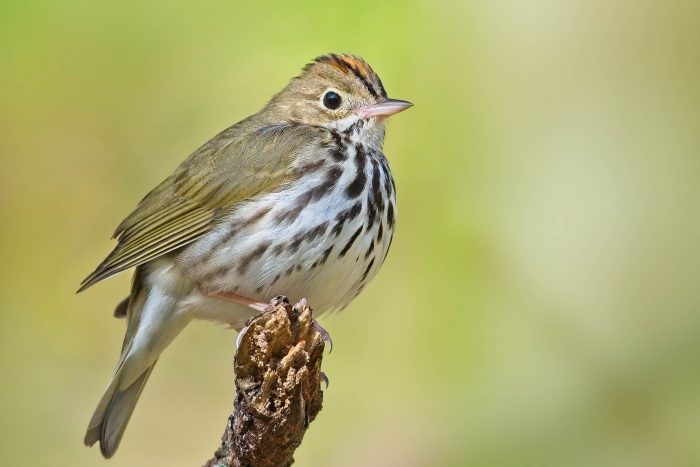Ovenbird
Seiurus aurocapilla
The ovenbird spends most of its time on the ground where you can find its unique, oven-looking nest.
This section shows one large critter image at a time. Use the thumbnails that follow to select a specific image to display here.

This gallery contains a grid of small thumbnails. Selecting a thumbnail will change the main image in the preceding section.
Appearance
The ovenbird is olive-green with a white and black spotted breast. It has orange and black stripes along its crows (or head) and white rings around its eyes. The bird has pink legs and a tail that is sloped upwards.
Feeding
Overbirds zig-zag along the forest floor foraging for food, almost like a chicken. They pick insects off of leaf litter and rotting logs, or sometimes catch them mid-air.
Predators
Raccoons, chipmunks, squirrels and snakes will prey on young ovenbirds and eggs. Species such as the brown-headed cowbird will join recently hatched ovenbirds (broods) and trick the parent into being fed and raised like the others. This is known as brood parasitism.
Flight
As a terrestrial bird, ovenbirds spend most of their time on land. However, they do fly and migrate hundreds of miles.
Voice
Overbird songs rise up in pitch, and sound like teacher-teacher-teacher-teacher.
Reproduction and life cycle
Males sing to attract females, and once they pair up, the female picks the nesting spot. Ovenbirds nest on the ground and build domed nests that they cover with leafy camouflage. The nest has a single opening that makes the nest resemble a Dutch Oven.
Female ovenbirds lay 4-5 eggs which are incubated by both parents. The young leave the nest after 10 days but still need to be fed by the parents for about 20 days.
Did you know?
If an ovenbirds nest is threatened, the mother will come out and pretend to have a broken wing to lure predators away.
Ovenbirds spend more time on the ground than most warblers.
Ovenbirds are more vocal than most warblers and will sing their song in the heat of the afternoon.
